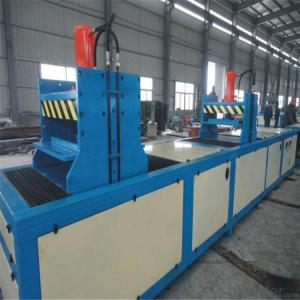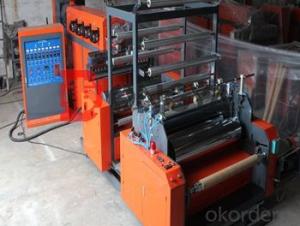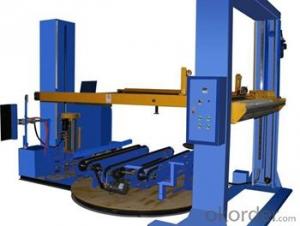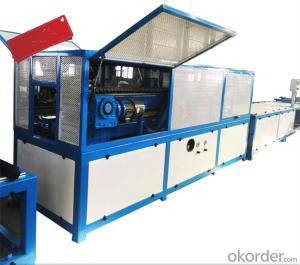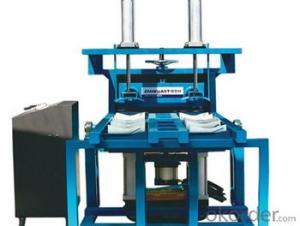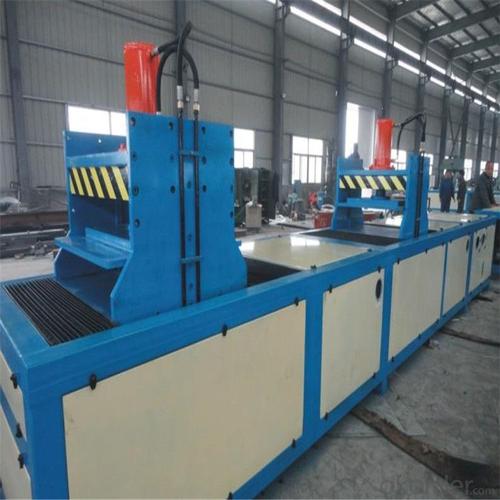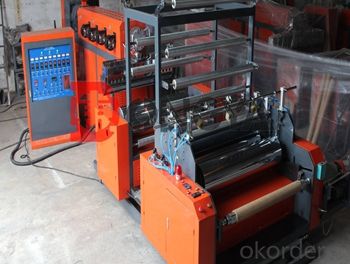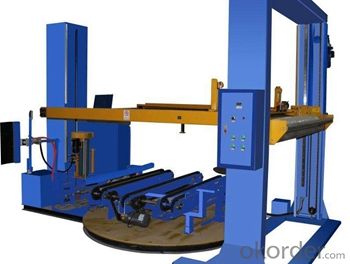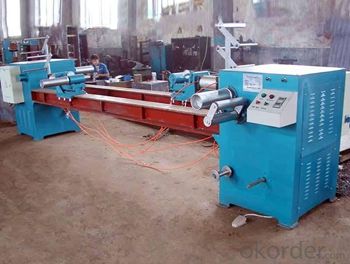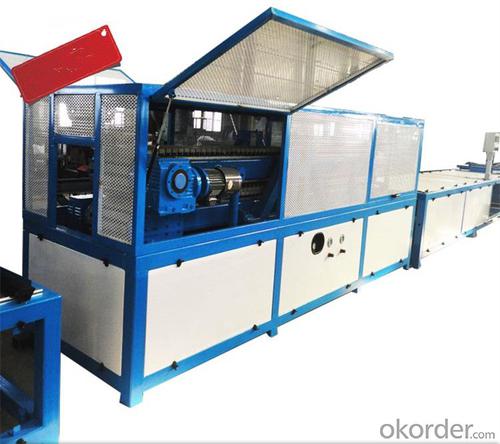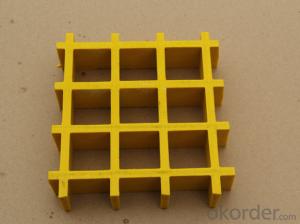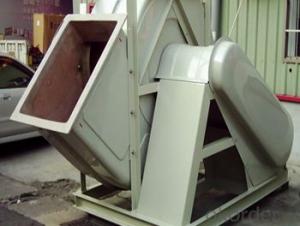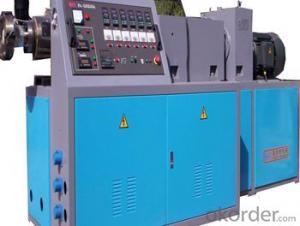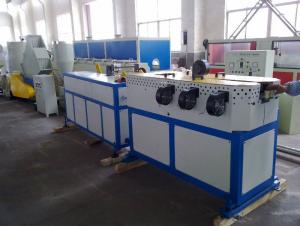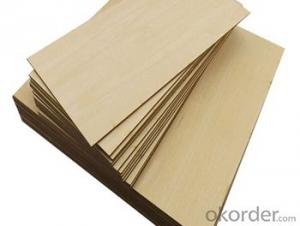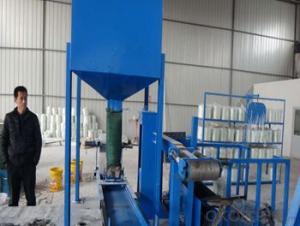FRP Pultrusion Profiles - Anti-Flammable FRP Pultruded Grating with Best Quality New Design
- Loading Port:
- Tianjin
- Payment Terms:
- TT OR LC
- Min Order Qty:
- 1 m.t.
- Supply Capability:
- 100000 m.t./month
OKorder Service Pledge
OKorder Financial Service
You Might Also Like
PRODUCT DESCRIPTION
Pultruded grating is made by a particular assembly process, which using “I” shape as its main load-bearing and special rod to go through the bearing bar. Pultruded grating include the standard grating and the custom grating, the custom grating can be designed to meet customer’s requirement or special using condition by changing the shape, size and space of the bearing bars, the surface can be covered with lozenge panel, grit panel, or added the anti-slippery sand directly.
FRP pultruded grating has the most characteristics of molded grating, but it has its distinct advantages, it has very high fiberglass content in the loading direction, so it has very high load capability, it has more superiority when used at wide span, so that the basic support will be decreased and the project cost will be reduced accordingly.
SPECIFICATION
The standard space between two crossbars is 6 inch or 12 inch.
Thickness (mm) | Bar width (mm) | Open space (mm) | Open rate (%) | Approx weight (kg/m |
25.4 | 15.2 | 22.8 | 60 | 13.2 |
25.4 | 15.2 | 15.2 | 50 | 15.9 |
25.4 | 15.2 | 10.1 | 40 | 18.5 |
25.4 | 40 | 10.8 | 21 | 14.5 |
38.1 | 15.2 | 22.8 | 60 | 15.8 |
38.1 | 15.2 | 15.2 | 50 | 19.1 |
38.1 | 15.2 | 10.1 | 40 | 22.4 |
50.8 | 25.4 | 25.4 | 50 | 16.6 |
50.8 | 25.4 | 12.7 | 33 | 21.1 |
CHOICE FOR PULTRUDED GRATING
Resin: GP resin, ISO resin, VE resin, Phenol resin
Color choice: Yellow, gray, green, custom color
Surface choice: Groove surface, grit surface, lozenge cover surface
FIELDS SERVED
Sewage treatment,
water supply and drainage,
chemical industry,
oil industry,
power engineering,
pulp and paper,
construction engineering,
spinning, marine engineering.
APPLICATION
Operation terrace,
stair walkway,
ground floor,
trench cover,
sidewalk,
foot bridge,
equipment safety fence,
scaffold.
COMPANT DESCRIPTION
CNBM,China National Building Materials Group is a state-owned enterprise in charge of administrative affairs in china building materials industry. Established in 1984, CNBM is a large group corporation of building materials with total assets of 25 billion RMB and a total staff of 30,000.CNBM now owns 200 subordinating firms of solely owned and joint-venture companies.
CNBM International Corporation is one subsidiary of CNBM, we focus on offering good-quality products,professional service and complete solution to our customers. Strong delivery capacity, advanced technology& management, strong financing capability and excellent after-sale service are our advantages in sharing international market.
FAQ
Q1.What's your sample policy?
A:We can supply the sample if we have ready parts in stock, but the customers have to pay the courier cost.
Q2.Can you produce according to the samples?
A: Yes, we can produce or modify the products according to your request.
Q3.How do you deliver the goods to my country?
A:We can provide international express, such as DHL, EMS, UPS, FedEx, etc. We select air freight and sea freight upon your requests. Quotations if without mentioning the shipping costs are shipping fee excluded.
Q4.How much does it cost to ship to my country?
A:When you goanna to place an order, please contact us, because different country has different freight.
Q5.How to get the catalogue?
A:please contact us and tell us what you are looking for.
We will try our best to meet customers' demands. Welcome you come here to visit us. We sincerely welcome partners around the world to establish business cooperation with us on the basis of mutual trust, benefit and development.
PICTURES
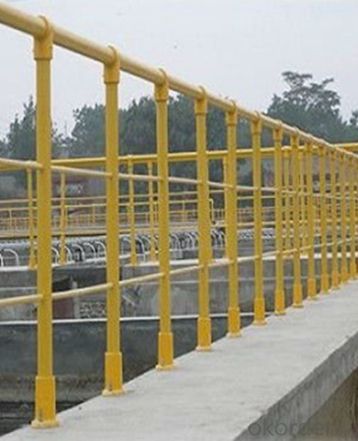

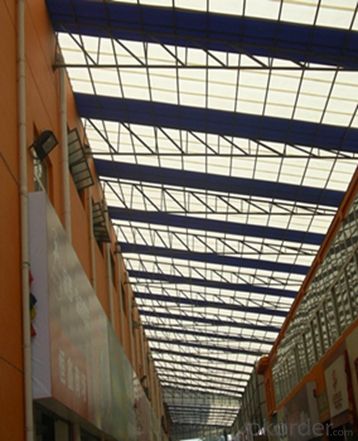
- Q: Are FRP pultrusion profiles resistant to impact?
- Yes, FRP (Fiber Reinforced Polymer) pultrusion profiles are generally resistant to impact. The combination of the high-strength fibers and the polymer matrix used in the manufacturing process makes FRP profiles highly durable and able to withstand significant impacts without cracking or breaking. Additionally, the pultrusion process ensures that the fibers are uniformly distributed throughout the profile, further enhancing its impact resistance. This makes FRP pultrusion profiles ideal for applications where impact resistance is important, such as in construction, transportation, and infrastructure projects.
- Q: Are FRP pultrusion profiles resistant to hydrocarbons?
- Yes, FRP (Fiber Reinforced Polymer) pultrusion profiles are generally resistant to hydrocarbons. The combination of various reinforcing fibers such as fiberglass or carbon fiber with a polymer matrix makes FRP materials highly resistant to chemical corrosion, including hydrocarbons. This resistance makes FRP pultrusion profiles a suitable choice for applications where exposure to hydrocarbons is expected, such as in oil and gas industry, chemical processing plants, or fuel storage facilities. However, it is important to note that the level of resistance can vary depending on the specific type of resin used in the FRP material and the concentration and temperature of the hydrocarbons involved. Therefore, it is recommended to consult with the manufacturer or supplier of the FRP pultrusion profiles to ensure their compatibility with the specific hydrocarbon environment in question.
- Q: Can FRP pultrusion profiles be used in infrastructure projects?
- FRP pultrusion profiles are capable of being utilized in infrastructure projects, indeed. These profiles provide several benefits when compared to conventional materials, like steel and concrete. To begin with, FRP profiles possess a lightweight characteristic, while still maintaining high strength-to-weight ratios. This quality facilitates their transportation and installation, ultimately reducing construction time and expenses. Moreover, their lightweight nature ensures that they do not exert excessive loads on the supporting structures. In addition, FRP profiles exhibit resistance to corrosion. Unlike steel, FRP does not rust or corrode when exposed to harsh environmental conditions, making them ideal for infrastructure projects situated in coastal areas or regions with high humidity. This corrosion resistance extends the lifespan of the structures and diminishes maintenance requirements, resulting in long-term cost savings. Furthermore, FRP pultrusion profiles offer exceptional durability and dimensional stability. They display high resistance to fatigue, creep, and environmental degradation, guaranteeing the longevity and structural integrity of the infrastructure. Their dimensional stability also ensures that they retain their shape and structural properties over time, minimizing the risk of deformation or failure. Moreover, FRP profiles can be customized to meet specific project requirements. They can be manufactured in various shapes, sizes, and strengths, allowing for versatile applications in infrastructure projects such as bridges, walkways, railings, support structures, and utility poles. All in all, the utilization of FRP pultrusion profiles in infrastructure projects presents numerous advantages, including lightweight construction, corrosion resistance, durability, and customization options. These benefits establish FRP profiles as a viable and cost-effective alternative to traditional materials for a wide range of infrastructure applications.
- Q: Are FRP pultrusion profiles resistant to impact from flying debris?
- FRP pultrusion profiles possess notable strength and durability, earning them a reputation in the industry. Their inherent properties make them generally impervious to damage caused by flying debris. This exceptional impact resistance can be attributed to the combination of reinforcing fibers, often fiberglass, and the polymer matrix. The extent of resistance to flying debris impact may vary depending on the design, thickness, and composition of the FRP pultrusion profiles. Nevertheless, these profiles are typically engineered to withstand impact forces and effectively withstand damage from airborne debris. Moreover, FRP pultrusion profiles find extensive use in industries such as construction, transportation, and infrastructure, where impact resistance is of utmost importance. These profiles have undergone rigorous testing and have demonstrated their ability to endure various impact scenarios, making them a trustworthy choice for applications that involve the potential for flying debris. It is vital to recognize that although FRP pultrusion profiles boast commendable impact resistance, the severity of the impact and the speed of the flying debris can still impact the degree of damage incurred. Thus, it is advisable to consult with the manufacturer or an engineer to ensure the chosen FRP profile is suitable for the intended application and potential impact conditions.
- Q: Are FRP pultrusion profiles resistant to termites?
- FRP pultrusion profiles are typically immune to termites. Termites mainly consume materials that contain cellulose, such as wood. However, FRP pultrusion profiles, composed of resin and glass fibers, lack cellulose and are hence unappealing to termites. As a result, FRP pultrusion profiles offer an excellent substitute for conventional wooden profiles in situations that demand termite resistance, like building construction and outdoor structures. Furthermore, FRP profiles demonstrate resistance against decay, corrosion, and various environmental elements, rendering them a robust and enduring material option.
- Q: How do FRP pultrusion profiles perform in extreme cold temperatures?
- Due to the properties of the materials used, FRP pultrusion profiles perform exceptionally well in extremely cold temperatures. These profiles, made of FRP composites, are known for their excellent thermal insulation properties, which help maintain their structural integrity even in low temperatures. One major advantage of FRP pultrusion profiles in cold environments is their ability to resist freezing and thawing cycles. Unlike other materials, FRP does not absorb water, thus preventing expansion or contraction with temperature changes. This eliminates the risk of cracking or damage that can occur when moisture freezes and expands within traditional materials like metal or concrete. Moreover, FRP pultrusion profiles have a low coefficient of thermal expansion, meaning they do not significantly expand or contract with temperature fluctuations. This stability allows them to maintain their shape and structural integrity in extreme cold, reducing the chances of deformation or failure. Aside from their thermal properties, FRP pultrusion profiles also exhibit high strength and durability, making them suitable for various applications in construction, infrastructure, and transportation, even in harsh cold environments. They are resistant to corrosion, chemicals, and UV radiation, further enhancing their performance and longevity in extreme conditions. In conclusion, FRP pultrusion profiles are an excellent choice for applications requiring reliable performance in extreme cold temperatures. With their thermal insulation properties, resistance to freezing and thawing cycles, low coefficient of thermal expansion, and overall strength and durability, they are well-suited for various industries and environments, ensuring their continued performance even in the harshest cold conditions.
- Q: Can FRP pultrusion profiles be used in mining applications?
- Mining applications can utilize FRP pultrusion profiles, which are known for their high strength-to-weight ratio, durability, and corrosion resistance. These profiles are suitable for a range of purposes in mining operations. They can provide structural support in underground mines, including the construction of tunnels, shafts, and mine roofs. Their strength allows them to handle heavy loads and provide long-term support. Additionally, FRP pultrusion profiles can support equipment and machinery like conveyor systems, pumps, and tanks. Their corrosion resistance makes them ideal for use in harsh mining environments that involve exposure to moisture, chemicals, and abrasive materials. Moreover, FRP pultrusion profiles can be used for safety applications in mining, such as handrails, walkways, and grating systems. These profiles offer reliable and non-slip surfaces, ensuring the safety of mining workers. In summary, FRP pultrusion profiles bring several advantages to mining applications, including high strength, corrosion resistance, durability, and easy installation. These qualities make them a cost-effective and viable option for various mining operations, enhancing efficiency and safety in the industry.
- Q: Are FRP pultrusion profiles resistant to moisture absorption?
- FRP pultrusion profiles possess remarkable resistance to moisture absorption, primarily due to the composition of the materials used in their construction. These profiles typically consist of a combination of fiberglass and resin, wherein fiberglass is naturally non-porous and impervious to moisture, while the resin is specifically designed to repel moisture. The moisture resistance of FRP profiles is further enhanced by the pultrusion manufacturing process. This process involves pulling the fiberglass and resin through a heated die, ensuring thorough impregnation of the fibers with resin and creating a dense and solid structure. Consequently, the resulting product exhibits exceptional resistance to water penetration and moisture absorption. Additionally, the moisture resistance of FRP pultrusion profiles can be augmented through the application of protective coatings or surface treatments, such as gel coats or UV-resistant finishes. These coatings provide an extra layer of defense against moisture ingress. The superior moisture resistance of FRP pultrusion profiles makes them an ideal choice for applications that involve exposure to water or high humidity, such as marine environments, wastewater treatment plants, or outdoor structures. By preventing issues like rot, rust, or degradation commonly associated with materials like wood or metal, these profiles offer a reliable and durable solution that can endure moisture exposure without compromising their structural integrity or performance.
- Q: Are FRP pultrusion profiles resistant to sulfuric acid?
- FRP pultrusion profiles display a notable resistance to sulfuric acid and this corrosion resistance is a key advantage they hold over traditional materials like steel or concrete. Sulfuric acid, known for its highly corrosive nature, poses no threat to FRP pultrusion profiles due to the inherent properties of the composite materials used in their construction. The primary reason behind the corrosion resistance of FRP profiles lies in the resin matrix that encases the reinforcing fibers. The commonly utilized resins in pultrusion, namely polyester, vinyl ester, and epoxy, exhibit remarkable chemical resistance, including resistance to sulfuric acid. However, it is essential to acknowledge that the resistance of FRP pultrusion profiles to sulfuric acid can vary based on multiple factors. The concentration and temperature of the acid, as well as the specific resin formulation employed in the profile, can impact the overall resistance. In scenarios involving highly concentrated acid or elevated temperatures, it is advisable to consult the manufacturer or supplier to ensure that the specific FRP profile meets the necessary resistance requirements. On the whole, FRP pultrusion profiles offer a high level of resistance to sulfuric acid, making them apt for a wide range of applications in industries where this corrosive substance may be present, such as chemical processing, wastewater treatment, or mining.
- Q: Can FRP pultrusion profiles be used in the construction of oil storage tanks?
- Yes, FRP (Fiber Reinforced Polymer) pultrusion profiles can be used in the construction of oil storage tanks. FRP pultrusion profiles offer several advantages in this application. Firstly, FRP is highly resistant to corrosion, which is crucial for oil storage tanks as they are constantly exposed to harsh environmental conditions and the corrosive nature of oil. This makes FRP pultrusion profiles a suitable alternative to traditional construction materials like steel, which is prone to corrosion and requires frequent maintenance. Additionally, the lightweight nature of FRP pultrusion profiles makes them easier to handle and install compared to heavy steel components. This reduces construction time and costs, making FRP an attractive option for oil storage tank construction. Furthermore, FRP pultrusion profiles offer excellent strength and durability, ensuring the structural integrity of the oil storage tanks. The material's high strength-to-weight ratio allows for efficient load-bearing and structural performance. Moreover, FRP pultrusion profiles can be customized to meet specific design requirements, allowing for flexibility in tank design and construction. The pultrusion process enables the production of complex shapes and sizes, providing engineers with the ability to optimize the tank's design for maximum efficiency. Lastly, FRP is non-conductive and has high electrical resistance, making it a safe choice for oil storage tanks. This eliminates the risk of electrical hazards that may occur in tanks constructed with conductive materials. In conclusion, FRP pultrusion profiles can indeed be used in the construction of oil storage tanks, offering numerous advantages such as corrosion resistance, lightweight construction, high strength, design flexibility, and electrical safety.
Send your message to us
FRP Pultrusion Profiles - Anti-Flammable FRP Pultruded Grating with Best Quality New Design
- Loading Port:
- Tianjin
- Payment Terms:
- TT OR LC
- Min Order Qty:
- 1 m.t.
- Supply Capability:
- 100000 m.t./month
OKorder Service Pledge
OKorder Financial Service
Similar products
Hot products
Hot Searches
Related keywords
